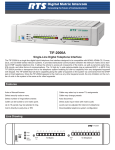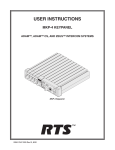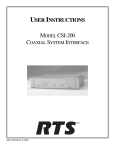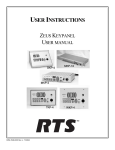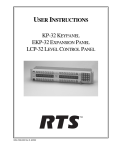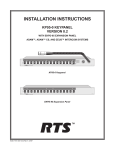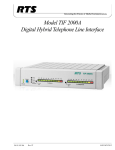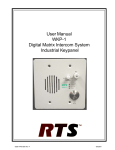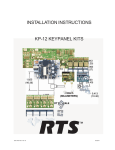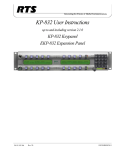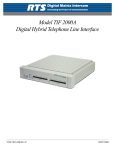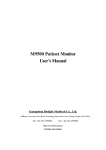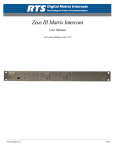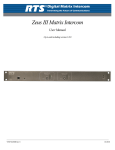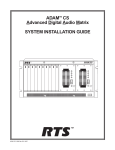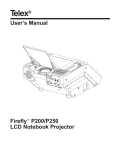Download TIF 2000
Transcript
USER MANUAL Model TIF 2000 Digital Hybrid Telephone Line Interface 9350-7674-000 Rev B, 4/2003 1 PROPRIETARY NOTICE The RTS product information and design disclosed herein were originated by and are the property of Telex Communications, Inc. Telex reserves all patent, proprietary design, manufacturing, reproduction, use and sales rights thereto, and to any article disclosed therein, except to the extent rights are expressly granted to others. CUSTOMER SUPPORT Technical questions should be directed to: Customer Service Department RTS/Telex, 12000 Portland Avenue South Burnsville, MN 55337 U.S.A. Telephone: (952) 884-4051 Fax: (952) 884-0043 COPYRIGHT NOTICE Copyright © 2001 by Telex Communications, Inc. All rights reserved. Reproduction in whole or in part without prior written permission from Telex is prohibited. RETURN SHIPPING INSTRUCTIONS PROCEDURE FOR RETURNS If a repair is necessary, contact the dealer where this unit was purchased. WARRANTY INFORMATION RTS products are warranted by Telex Communications, Inc. to be free from defects in materials and workmanship for a period of three years from the date of sale. If repair through the dealer is not possible, obtain a RETURN AUTHORIZATION from: The sole obligation of Telex during the warranty period is to provide, without charge, parts and labor necessary to remedy covered defects appearing in products returned prepaid to Telex. This warranty does not cover any defect, malfunction or failure caused beyond the control of Telex, including unreasonable or negligent operation, abuse, accident, failure to follow instructions in the Service Manual or the User Manual, defective or improper associated equipment, attempts at modification and repair not authorized by Telex, and shipping damage. Products with their serial numbers removed or effaced are not covered by this warranty. Customer Service Department Telex Communications, Inc. Telephone: (877) 863-4169 Fax: (800) 323-0498 DO NOT RETURN ANY EQUIPMENT DIRECTLY TO THE FACTORY WITHOUT FIRST OBTAINING A RETURN AUTHORIZATION. Be prepared to provide the company name, address, phone number, a person to contact regarding the repair, the type and quantity of equipment, a description of the problem and the serial number(s). To obtain warranty service, follow the procedures entitled “Procedure For Returns” and “Shipping to Manufacturer for Repair or Adjustment”. SHIPPING TO MANUFACTURER FOR REPAIR OR ADJUSTMENT All shipments of RTS products should be made via United Parcel Service or the best available shipper, prepaid. The equipment should be shipped in the original packing carton; if that is not available, use any suitable container that is rigid and of adequate size. If a substitute container is used, the equipment should be wrapped in paper and surrounded with at least four inches of excelsior or similar shock-absorbing material. All shipments must be sent to the following address and must include the Return Authorization. This warranty is the sole and exclusive express warranty given with respect to RTS products. It is the responsibility of the user to determine before purchase that this product is suitable for the user’s intended purpose. ANY AND ALL IMPLIED WARRANTIES, INCLUDING THE IMPLIED WARRANTY OF MERCHANTABILITY ARE LIMITED TO THE DURATION OF THIS EXPRESS LIMITED WARRANTY. NEITHER TELEX NOR THE DEALER WHO SELLS RTS PRODUCTS IS LIABLE FOR INCIDENTAL OR CONSEQUENTIAL DAMAGES OF ANY KIND. Factory Service Department Telex Communications, Incorporated West 1st Street Blue Earth, MN 56013 U.S.A. Upon completion of any repair the equipment will be returned via United Parcel Service or specified shipper collect. 2 Table of Contents INTRODUCTION .................................................................................................................................... 4 DESCRIPTION ........................................................................................................................................ 4 Front Panel Features .................................................................................................................................................................. 4 Rear Panel Features ................................................................................................................................................................... 4 INSTALLATION ...................................................................................................................................... 4 Unpacking .................................................................................................................................................................................... 4 Rear Panel DIP Switch (S201) ................................................................................................................................................... 4 Auto Answer ................................................................................................................................................................. 4 Generate Ring Signal ................................................................................................................................................... 4 Password Required ...................................................................................................................................................... 4 Intercom Port Address ................................................................................................................................................. 4 Full Duplex Method ..................................................................................................................................................... 6 Internal DIP Switch (S202) ........................................................................................................................................................ 6 Ring Count .................................................................................................................................................................... 6 DTMF or Pulse Dial Selection ..................................................................................................................................... 7 Point-to-Point Seize ...................................................................................................................................................... 7 One Touch Dial ............................................................................................................................................................. 7 Fast Seize ....................................................................................................................................................................... 7 DSP Full or Half Duplex Selection .............................................................................................................................. 7 Audio Ducking .............................................................................................................................................................. 7 Internal DIP Switch (S203) ........................................................................................................................................................ 7 Rack Mounting ........................................................................................................................................................................... 7 Connections ................................................................................................................................................................................. 7 Intercom ........................................................................................................................................................................ 7 Telephone and Telephone Line .................................................................................................................................... 7 Power Supply ................................................................................................................................................................ 8 Setting Audio Levels ................................................................................................................................................................... 9 Setting audio levels to intercom matrix ...................................................................................................................... 9 Setting audio levels to telephone line .......................................................................................................................... 9 Configuring for Country’s Telephone System .......................................................................................................................... 9 OPERATION ............................................................................................................................................ 9 Operation From A Keypanel ..................................................................................................................................................... 9 Programming a key to use the TIF 2000 .................................................................................................................... 9 Dialing a call ............................................................................................................................................................... 10 Hanging up .................................................................................................................................................................. 10 Re-dialing the last number ........................................................................................................................................ 10 Dialing a speed dial number ...................................................................................................................................... 10 Storing a speed dial number ...................................................................................................................................... 10 Answering a call ......................................................................................................................................................... 10 TIF 2000 System Setup to Receive Calls ................................................................................................................................ 11 Auto Answer Mode ..................................................................................................................................................... 11 Manual Answer Mode ................................................................................................................................................ 11 Using The TIF 2000 From The Telephone .............................................................................................................................. 11 DTMF Codes ............................................................................................................................................................... 12 SPECIFICATIONS ................................................................................................................................ 13 TELEPHONE INTERFACE REQUIREMENTS FORM .................................................................. 14 3 INTRODUCTION INSTALLATION This manual describes the installation, programming, and operating procedures for the RTS Model TIF 2000 Digital Hybrid Telephone Line Interface. Since TIF 2000 functions as a keypanel, the user may also need to refer to the manuals and/or on-line help files for CSedit, ADAMedit, or ZEUSedit for information on configuring certain features. Unpacking The TIF 2000 shipping box should contain the following items: 1 TIF 2000 Unit 1 Power Supply 1 IEC Power cord 1 User Manual 1 Software Disk containing country specific telephone system configuration files. Important! Be sure to review any recently added supplemental information before proceeding. Supplements are placed at the back of the manual. If anything is missing or damaged, contact the shipper or Telex immediately. DESCRIPTION Rear Panel DIP Switch (S201) The rear panel DIP switch contains switches to configure the most often changed options. These include: auto answer on/off, ring signal on/off, password on/off, intercom port address, and full duplex method. The TIF 2000 is a single line digital hybrid telephone line interface designed to be compatible with ADAM, ADAM CS, ZEUS, and CS 9000 series intercom systems. It provides bi-directional communication between the intercom matrix and a standard DTMF capable telephone line. It allows the phone to access all crosspoints of the matrix, as well as dynamic party lines, IFB circuits, and other forms of communications. The 1U high by ½ wide rack mountable (via an optional kit) TIF 2000 provides a transparent link to the telephone system enabling full dial-out capability from any designated keypanel with keypad. The TIF 2000 has full dial-in capability giving the caller a keypanel on the system via commands from the DTMF pad on their telephone. Since the TIF 2000 appears to the matrix as any other keypanel would, the only limitation on the number of units in the system is the same as for other keypanels. Auto Answer Turning on the auto answer option will set the unit to answer the phone automatically when it rings. The number of rings required before it answers is determined by the setting of internal DIP switch (S202). If auto answer is turned off, the line will ring until someone at a keypanel answers the call or until the Select button on the TIF 2000’s front panel is pressed. To turn on auto answer, place switch 1 in the down position. To turn off auto answer, place switch 1 in the up position. Generate Ring Signal Turning on the generate ring signal option sets the unit so that when the phone line is ringing, keypanels that are configured to receive ring signals will produce an audible ring. To turn on the ring signal, place switch 2 in the down position. To turn off the ring signal, place switch 2 in the up position. Front Panel Features Power Indicator Line Mode Indicator Seizes & Drops Line Audio to Matrix Level Meter Audio to Matrix Level Adjustment Audio to Telephone Line Level Meter Password Required Turning on the password required option sets the unit so that when a call is automatically answered, the user must enter a password via DTMF before the unit will allow communications. The password numeric sequence and length are determined by the settings of internal DIP switch (S203). To turn on the password required option, place switch 3 in the down position. To turn off the password required option, place switch 3 in the up position. Audio to Telephone Line Level Adjustment Figure 1 - TIF 2000 Front Panel Features Rear Panel Features Intercom Matrix Connections Intercom Port Address Switches 4 to 7 determine the address of the unit. The port address is expressed in binary with switch 4 being the least significant bit (LSB) and switch 7 being the most significant bit (MSB). To turn on (set bit to 1), place the desired switch in the down position. To turn off (set bit to 0), place the desired switch in the up position. ADAM, ADAM CS, and Data Present Address & Telephone Line Power Configuration Connections Figure 2 - TIF 2000 Rear Panel Features 4 Table 1- Correspondence between address numbers and intercom port numbers for ADAM, ADAM CS, and Zeus systems 5 Table 2- Address DIP Switch Settings When using full duplex mode, users may hear an increased amount of echo on the line. This may be more pronounced when the TIF 2000 is forced into full duplex mode all of the time (switch 8 up) rather than only when audio is present (switch 8 down). Internal DIP Switch (S202) Internal DIP switch (see Figure 4) is accessed by removing the top cover. To remove the top cover, remove and loosen the screws as indicated in Figure 3. Remove the cover by lifting up on the back portion of the cover. To reinstall the cover, place the front portion into the grooves on the bottom cover and slide the cover toward the front of the unit while lowering the back of the cover. Replace and tighten the screws that were removed or loosened as indicated in Figure 3. Zeus units use a 1-8 address scheme for their ports (e.g. ports 1-8 have addresses 1-8, ports 9-16 have addresses 1-8, etc...). CS 9xxx systems use a 1-10 scheme for port addresses (e.g. ports 1-10 have addresses 1-10, ports 11-20 have addresses 1-10, etc...). Remove To set the address for ADAM, ADAM CS, or Zeus systems do the following: 1. Determine the port number that will be used for the TIF 2000. 2. Locate the port number and its corresponding address in Table 1. Loosen Figure 3 - TIF 2000 Internal DIP Switch Locations 3. Determine the DIP switch settings by looking up the address determined in the previous step in Table 2. 4. Set the DIP switches on the back of the unit. Internal DIP Switch (S202) To set the address for CS 9xxx systems do the following: Internal DIP Switch (S203) 1. Determine the intercom intercom port (audio channel number) that will be used for the TIF 2000. 2. For port numbers ending in 1 through 9, the address is the last digit of the port number. If the last digit is zero, use 10 as the address number Figure 4 - TIF 2000 Internal DIP Switch Locations Table 3- Ring Count Settings 3. Determine the DIP switch settings by looking up the address in Table 2. 4. Set the DIP switches on the back of the unit. Full Duplex Method Switch 8 controls the method by which full duplex operation is implemented in the unit. This switch only works if full duplex mode is set via internal DIP switch (S202), switch 7 (The factory default setting for Switch 7 is ON, full duplex mode.) If switch 8 is in the up positon, then the unit will be forced into full duplex mode all the time. If switch 8 is in the down position, then the unit will be forced into full duplex mode only when audio is present. Ring Count Switches 1 and 2 determine the number of rings before the unit auto answers. Note: The ring count is approximate. These switches have no effect unless switch 1 on the rear panel DIP switch bank is in the down position. To set the ring count, consult Table 3. 6 effect unless password required has been enabled on the DIP switch located on the rear panel. When password required is enabled, the password must be entered via DTMF by the caller before they may communicate. This is to prevent unauthorized use of the intercom by callers. See Table 5. DTMF or Pulse Dial Selection Switch 3 sets the the dialing mode to either Dual Tone Multi-Frequency (DTMF) or Pulse. When in the switch is in the Off position DTMF dialing is selected. When the switch is in the On position pulse dialing is selected. Point-to-Point Seize Switch 4 turns on and off the Point-to-Point Seize feature. When the switch is in the Off position normal line seize operation (via a keypanel) is selected. When the switch is in the On position a line will be seized immediately upon the designated TIF 2000’s talk key being pressed via the keypanel. Switches 7 and 8 select the length of the password, from 1 digit to 4 digits. If set for 1 digit only the first digit of the password is used, if set for 2 digits, then the first 2 digits are used etc. See Table 4. Table 4 - Password length DIP Switch Settings One Touch Dial Switch 5 enables/disables the One Touch Dialing feature. When the switch is in the Off position One Touch Dial is disabled. When the switch is in the On position One Touch Dial is enabled. Rack Mounting There are two options for rack mounting the TIF 2000. If a single unit is to be rack mounted attach an MCP-2 rack mount kit. If two units are to be mounted side-by-side, attach an MCP-1 rack mount kit. See Figure 5 for a depiction of the two rack mount kits. One Touch Dial works as follows: If a number is stored in Auto Dial memory 1 on the TIF 2000, and the line is on hook, then the TIF 2000 will autodial the number stored in Auto Dial memory 1 whenever any keypanel closes a point-to-point talk key to the TIF 2000. Fast Seize Switch 6 enables/disables the Fast Seize feature. If the switch is in the Off position Fast Seize is disabled. If the switch in in the On position Fast Seize is enabled. If Fast Seize is enabled and the unit is set to auto answer, then the TIF 2000 will answer or “seize” the line at the start of the first ring. It is important to note that a ring will not be heard on any of the keypanels. DSP Full or Half Duplex Selection Switch 7 determines either full duplex or half duplex operation. If the switch is set to the Off position, the DSP is forced into full duplex mode as determined by the setting of switch 8 on the DIP switch bank located on the rear panel of the TIF 2000. See Full Duplex Method for more information. If the switch is set to the On position, the DSP is never forced into full duplex mode. Figure 5 - Rack Mount Kits Audio Ducking Switch 8 enables/disables the Audio Ducking feature. If the switch is set to the Off position, Audio Ducking is disabled. If the switch is set to the On position, Audio Ducking is enabled. The Audio Ducking feature helps to eliminate feedback between the intercom system and the telephone line. Connections Intercom Use either of the “To Matrix” connectors (but not both) to connect to an intercom port. The intercom port that you connect to will determine the address of the unit (see Setting Address). Cable wiring diagrams are shown in Figures 6 and 7. An LED labeled “Data” is located next to the Matrix connectors and serves as a basic indicator of data flow. Internal DIP Switch (S203) Internal DIP switch (S203) selects the password. It has no Telephone and Telephone Line There are two telephone connections provided on the rear of 7 Table 5 - Password length DIP Switch Settings the TIF 2000. Plug the telephone line into the jack labeled “To Phone Line”. You may also plug a standard telephone into the jack labeled “Loop Thru”. Note: The standard telephone plugged into the “Loop Thru” jack is disconnected when the TIF 2000 seizes the telphone line. Power Supply Insert the round connector from the brick type power supply into the power connector on the rear of the TIF 2000. Turn the locking ring on the connector to secure the connection. Plug the female end of the IEC type power cord into the power supply and then plug the other end into an appropriate power outlet. Figure 6 - RJ12 Intercom Cable Figure 7 - DE9 Intercom Cable 8 Setting Audio Levels Audio levels to the intercom matrix and to the telephone line can be adjusted via the trim pots located on the front panel. Setting audio levels to intercom matrix Adjustment may be made via the front panel control (see Figure 1). To adjust the control use a small flat blade screwdriver or trimpot adjustment tool. Initially set the front panel level control for mid range. Have the caller talk at their normal level and adjust the control for the best audio quality while avoiding going into the red section of the audio meter (to Matrix) located on the front panel. Setting audio levels to telephone line Adjustment may be made via the front panel control (see Figure 1). To adjust the control use a small flat blade screwdriver or trimpot adjustment tool. Initially set the front panel level control for mid range. Talk at your normal level and adjust the control for the best audio quality while avoiding going into the red section of the audio meter (to Telephone) located on the front panel. Configuring for Country’s Telephone System The TIF 2000 should be configured to work with the telephone system to which it is connected. Each country or area of the world has unique signaling differences that could cause erratic operation of the TIF 2000 if it is not properly configured. If the system you intend to connect is not currently supported, you may request a configuration using the form located in the back of this manual. To configure the unit for use with a specific country’s telephone system do the following: Note: ADAMedit and ZEUSedit must be configured to allow firmware downloads. 1. Connect the TIF 2000 to the intercom system. 2. Run the ADAM Edit or ZEUS Edit software and go to the keypanel software versions screen. This is located under the Status menu. Go to |Status| |Software Versions| |Keypanels|. 3. Click on the entry for the TIF 2000 you wish to configure. 4. The configurations are in a self extracting archive on the included floppy disk. Extract and copy these files to a known location on the computer connected to the intercom matrix 5. Press CTRL + SHIFT + D to start the software download process. A download screen should appear. 6. Select the location that you copied the files to in step 4 and select the file corresponding to the country needed. 7. Click on the OK button. Once the software versions window reappears, the process is complete. The status reported for the TIF 2000 contains a number corresponding to the country configuration. This is reported as LOCALE = XX where XX is a specific number for each country. The current possible configurations are: LOCALE # 0 1 2 3 4 5 6 7 8 9 10 11 12 CUST Country or Countries North America, Korea, Taiwan Belgium France Germany United Kingdom (UK) Italy Japan Netherlands Norway Not Used Singapore Brazil, Sweden Ireland Custom Configuration OPERATION Operation From A Keypanel The TIF 2000 is operated from the intercom keypanels, and from the dial pad on the telephone at the remote end of the line. Any keypanel with a keypad may use a TIF 2000. All that is necessary is to program a key to talk to the TIF 2000, as if it were a keypanel. The alpha numeric display or tally LED for that key then provides information about the phone line. A solid display or non illumined LED indicates a line which is not in use. A slow flash indicates a line which is in use (off hook). A rapidly flashing display or LED indicates a line which is ringing. In addition, the alpha numeric display will display digits as they are dialed, and the LED will flash for each digit. Note: Displayed tallies will be different if the “Don’t generate tallies for TIF or trunk use” option has been selected in |Options| |Intercom Configuration|. Programming a key to use the TIF 2000 To use the TIF 2000, either to answer a call, or to call out, you first need to program a key to talk to the TIF 2000. This is accomplished in the same manner as programming a key to talk to a key panel. To program a key by port number, enter NUM-nnn-PGM-t, where NUM is the number 1 key, nnn is the port number of the TIF 2000 you want to use, and t is any talk key. In general, you will also need to use the listen key, so it should be assigned as either AF (auto 9 follow), or AL (auto listen). Note: If the talk key is in the on position, you must turn off the key, then momentarily turn it on again to indicate which line you wish to disconnect. If the line is in dialing mode, then you must first exit dialing mode by turning off the key, then use PHONE-CLR-t to hang up. Note: The TIF 2000 only responds to commands which are sent via a point-to-point key assignment. If you wish to use the TIF 2000 primarily on a PL, you must add a point to point assignment as the L2 talk assignment on the talk key for any panels which are going to either answer the line, or dial out on the line. Re-dialing the last number The TIF 2000 remembers the last number which it has dialed. Dialing a call Any key panel may dial calls on the TIF 2000. 1. Enter dialing mode by following the instructions for dialing a call. To dial a call on the TIF 2000; 1. Turn on the listen key for the line you wish to dial on. This will allow you to hear dial tone, and your DTMF dialing tones. 2. Enter CLR-0-0. The TIF 2000 will automatically redial the last number it dialed. 3. Momentarily release the talk key to exit dialing mode. 2. Enter dial mode by entering PHONE-PGM-T. PHONE is the 4 button on the keypad. PGM is the red PGM key on the keypad, and T is the talk key which is programmed to talk to the TIF 2000 you are dialing on. Leave the talk key in the latched position as you dial the number. For example: If you have a call to 818-566-6700 and you are disconnected, issuing the redial command will reestablish the call. The redial command may be issued from any keypanel in the intercom, not just the keypanel that originally dialed the call. 3. Dial the number. As you enter each digit, it will appear in the alpha display above the key you are dialing on. If the listen key is latched, you will hear each DTMF tone as it is generated. Dialing a speed dial number The TIF 2000 has 24 internal memories for storing frequently used phone numbers. To dial one of these numbers: 4. When you have completed dialing, momentarily turn off the talk key to exit dial mode. The alpha numeric display will revert to normal, and you may use the key and keypad in the normal manner. 1. Enter dial mode. Note: The keypad is used in the usual way. Digits 0-9 generate the DTMF digits 0-9. PGM generates #, and CLR generates *(# and * are displayed for these keys). 3. Momentarily release the talk key to exit dialing mode. 2. Enter CLR-nn where CLR is the clear button on the key pad, and nn is two digits, which are the speed dial code. Storing a speed dial number 1. After dialing the number the usual way, but before exiting dial mode, enter the CLR-PGM-nn before you release the talk key to exit dialing mode. It is necessary to press CLR twice if you wish to generate a *, as a single CLR is used to trigger the speed dial and redial features. 2. Momentarily release the talk key to exit dialing mode. Hanging up The TIF 2000 will detect that the caller at the far end has hung up under most circumstances. It detects the hang up by either loop interrupt, battery reversal, or the presence of dial tone or a busy signal. Some telephone systems do not provide any of the above, so it will be necessary to force a hang up. In addition, if the call was placed to an auto answer device, it will be necessary to force a hang up when the call is complete. Note: To generate a pause during auto dial, enter *99. This is used for example if you need to enter a digit to get an outside line, and your phone system requires a pause before continuing to dial. Each number may contain up to 25 digits. A TIF 2000 can have different numbers stored in it. Unlike the TIF 951, the TIF 2000 stores the numbers in non-volitile memory and therefore does not require a UPS to maintain stored speed dial numbers. Enter PHONE-CLR-t, where PHONE is the 4 button on the key pad, CLR is the CLR button, and t is the talk key which is programmed to talk to the TIF 2000 which you wish to hang up. This will disconnect the line for which you struck the talk key. 10 Answering a call 1. When a line is ringing, the alpha numeric display or LED above the talk key which is programmed for that line will flash rapidly. wish to use. For example, if key #1 was the camera PL, and you have finished with the shot, you may press #1, which will toggle off key 1. If master control were programmed on key #2, you may then press 2 and call master control. Likewise, you might have an IFB programmed on listen 3, with no talk. If you press 3, you will hear the IFB. #4 could have an IFB talk on it, to allow a caller to speak on an lFB circuit. 2. To answer the call, first turn on the listen key, then press the talk key and speak into the microphone or headset. 3. If you have been programmed as a default station, your panel will “ring” whenever one of the lines rings. If you do not have a key already programmed, the ringing line will appear on your incoming call key (the key farthest to the right on the main panel also known as the Call Waiting Window or CWW). To answer, press the incoming call key and answer. You should copy the key to a main key position, either just before or just after you answer, so you can turn on the listen key to hear the caller audio. Each DTMF button acts as if it were a push on/push off switch. When programming in ADAMedit, just program the same key number as the number the user is going to press on the telephone to speak. Talk keys 8 to 15 have a special purpose. If you are not using auto answer mode, but have set up the TIF 2000 to be manually answered, talk keys 8 to 15 will be programmed for the keypanels which are to receive the ring signal. They may also be toggled on and off from the phone by DTMF 8, so they may be used in auto answer mode as well. You may program only key 8, in which case it will behave the same as keys 1-7. You may also program additional keypanels, PLs, IFB’s etc on keys 9-15, and they will be activated simultaneously by the 8 button on the phone. TIF 2000 System Setup to Receive Calls To the intercom system, the TIF 2000 is very much like a keypanel. If the phone lines are to be used for outgoing calls only, then no programming in ADAMedit is necessary. If users are going to phone into the intercom from the outside, then the TIF 2000 needs to be configured to allow them to use the phone line in much the same way a local user uses his key panel. Programming information for the phone line is entered into the ADAMedit software just as if the TIF 2000 were an ordinary keypanel, by selecting “Keys” from the main menu, then selecting the TIF 2000 from the pick list of key panels. The TIF 2000 operates much the same way as a key panel, except that the “keys” are really the DTMF buttons on the users telephone. Manual Answer Mode In manual answer mode, the line will ring until it is answered from a keypanel. In general, you must designate panels which are to receive the ring, so they can answer the line. When a line is manually answered, the caller does not have to enter a password, even if the password required switch is turned on. You may mix modes by enabling auto answer, but setting the ring count for 8 rings. If no user has answered the call by 8 rings, the TIF 2000 will then automatically answer the call, and if password required is also enabled, the call will be screened by requiring a password. Auto Answer Mode To use the TIF 2000 in auto answer mode, you must first enable auto answer mode on the rear panel DIP switch bank, switch 1. You may also wish to enable Password required, switch 3. In addition, you may select the number of rings before the unit answers (internal DIP switch bank #2), and the actual password (internal DIP switch bank #3). To use manual answer mode, you may choose to program keys 1 to 7 as above if you wish. When the phone is manually answered, key one will not be automatically activated, but the caller may activate any of the keys if he wishes. When the caller dials into the TIF 2000, they will hear the line ring, then the unit will answer, and beep to request the password (if password required is enabled). The user then must enter the password. The unit will beep once to confirm a proper password. If the password is not correct, the unit will beep twice to allow another try. You must also designate the panels which are going to ring when the line rings. Program these panels on keys 8 to 15, using both Ll and L2 if you have more than 8. It is generally not necessary to program the listen keys on these positions. When the line rings, the TIF 2000 will “call” these panels when the line is ringing. When the line rings, the TIF 2000 generates a ringer noise which is then transmitted to these panels. The panels will display the TIF 2000’s alpha numeric in the incoming call window (CWW), and if a talk key has already been programmed on the panel, its alpha numeric will flash rapidly. Once the password has been entered, the TIF 2000 will establish communications on key #1 automatically. From ADAMedit, this will be talk and listen keys #1. If for example the user were a camera operator, it might be desirable to program the camera PL as talk and listen on talk and listen keys #1. If the caller were a reporter, you might program an IFB on listen key #1, but no talk on talk key #1. Keys 2 to 7 may also be programmed. To use the other keys from the phone, just press the DTMF button for the key you Using The TIF 2000 From The Telephone 11 The TIF 2000 will behave differently depending on how it is programmed. It is up to the operator who programs the TIF 2000 to convey to the user what to expect. If the user is not familiar with the operation of the TIF 2000, it is best keep the operation as simple as possible, until they are familiar with its operation. For this reason, it is suggested that you not use password required unless you have had problems with nuisance calls in the past. If the TIF 2000 field user only requires one service, it is best to program that service on key 1, enable auto answer, and disable password required. The telephone user will then only have to dial the proper phone number to use the interface. As they become more familiar with its operation, you can then begin to offer more options to the users, or begin to require a password. 8 Toggle on and off talk and listen to the panels which ring when the line is ringing. This allows the caller to “recall” the panels without having to hang up and redial. Toggling this on will allow the callers voice to be heard from all the panels which normally ring. 9 Enters programming mode, to reassign keys. 0 Turn off all talk and listen keys. Since 1-8 are toggles, it is possible to forget which keys are “on” and which are “off”. In this case, just press 0 to turn then all off, and start over. *1 thru *7 Toggle on and off listen 1-7. By pressing * before the key, you only change the listen. This allows you to listen to a circuit without talking to it, or to talk to a circuit without listening to it. In general, it is very easy to use if the user has knows what to expect. When calling in, if the unit is in auto answer mode, it will answer the call after the number of rings which have been selected. If password required is not enabled, the unit will indicate it is ready with a single beep. If password required is enabled, the TIF 2000 will prompt for a password with 2 beeps. The user will enter the password, and the unit will either beep once if the password was correct, or twice if it was wrong. The user is allowed 3 attempts to enter the password, after which the TIF 2000 will disconnect. In the event a user calls the TIF 2000 when the intercom system is either turned off or absent, the TIF 2000 will answer and prompt with 3 beeps. Note: You will automatically listen and talk to #1 if the TIF 2000 auto answered the line. *8 Toggle on and off listen for 8-15. *# Disconnect. This will cause the TIF 2000 to hang up. It is a good idea to do this before you hang up, as many phone systems take a long time to signal that the far end has hung up. Programming Mode: Once the password is entered, the TIF 2000 will enable talk and listen on key 1. This should be programmed ahead of time to whatever communications the caller generally needs first. If it is not desirable for the caller to be able to talk at this point, then only the listen key for key 1 should be programmed. You may reprogram the talk and listen assignments on 1-7, just as you can on a keypanel (if they are not restricted via ADAMedit). Note that the sequences are the same as the sequence you would use from a keypanel, except that you must first enter programming mode by pressing 9. The caller may then either continue to use key 1, or they may select other keys with their DTMF pad. They may turn off key 1 by pressing DTMF 1, or may continue to just add other keys. At any time, the caller may turn off all keys without hanging up by pressing 0. When the call is complete, the caller should enter *#, which will cause the TIF 2000 to disconnect. This is more reliable than waiting for the phone system to pass the disconnect information to the TIF 2000. Note: The use of programming mode is discouraged due to a lack of feedback to the user to verify a programming sequence has worked as intended. DTMF Codes Once programmed, the TIF 2000 may be operated via the DTMF keypad on the telephone. The DTMF keys have the following functions: 1 nnn # K Program a talk key to a point to point. 2 nn # K Program a talk key to a PL. 01 nn # K Program a talk key to a special list. 02 nn # K Program a talk key to an IFB. 03 nn # K Program a talk ISO 04 nn # K Program a talk key relay. 35 #K Program a talk key to all call (turn on the lower numbered talk keys) 1 nnn # *K Program a listen key to a point to point. Normal Mode: 1 thru 7 Toggle on and off talk and listen #1 to #7. Note: Initially, #1 will be enabled if the unit auto answered the line. 12 2 nn # *K Program a listen key to a PL. SPECIFICATIONS 3 2 # *K Program a listen key to auto follow. 3 3 # *K Program a listen key to auto Mute Matrix Input/Output: 0 dBu to +20 dBu 01 nn # *K Program a listen key to a special list. 02 nn # *K Program a listen key to an IFB. 03 nn # *K Program a listen ISO 04 nn # *K Program a listen key to a relay. *9 Exit programming mode. Frequency Response: 300 Hz to 3.8 kHz +0 dB, -6 dB *0 Exit programming mode and turn off all talk & listen. *# Disconnect Matrix Connectors: DE-9S Female RJ12 Female Telephone Input/Output: -30 dBu to +6 dBu Noise (200 Hz to 3.8 kHz): -40 dBu or less Harmonic Distortion (300 Hz to 3.8 kHz): Intercom Side: -30 dBu or less Telephone Side: -25 dBu or less Telephone Line Connector: RJ11 Female Notes: 1. 0-9 are the number keys, * and # are the star and pound keys. 2. nnn is three digit for the panel number 3. nn is two digit for an IFB, PL, Relay, Special list, or ISO 4. K is a key which you are programming , just press the digit (1-7) 5. *K is the key followed by a digit (1-7). This is used to represent the listen key. Telephone Loop-Thru Connector: RJ11 Female Power Requirements: 100-240VAC, 50/60Hz, 1A Environmental: Operating Temperature: 0°C to 50°C Storage Temperature: -20°C to 75°C Humidity (Operating & Storage): 0 to 95%, non-condensing Dimensions: 1.72” (44mm) high 8.19” (208 mm) wide 8” (203 mm) deep Weight: 4.4 lbs. (2.0 kg) Finish: Thermoplastic front panel, aluminum case and rear panel, light gray finish Approvals: CE, UL, FCC SPECIFICATIONS SUBJECT TO CHANGE WITHOUT NOTICE 13 TELEPHONE INTERFACE REQUIREMENTS FORM October 20001 The Telex TIF 2000 Digital Hybrid Telephone Line Interface has been designed to respond to ringing for auto-answer and to respond to a number of conditions to detect hang-up. These conditions are (in the standard product) based upon the telephone systems of the US and other select countries. PBX (private branch exchange) systems in the US and other countries may have ringing and hang-up characteristics which differ from the design parameters used in the TIF 2000. Public telehone systems in countries other than those currently supported by Telex may have ringing and hang-up characteristics which differ from the design parameters used in the TIF 2000. Additionally, some countries require governmental approval for connection of the TIF 2000 to the public telephone system. Telex handles these requirements on a case by case basis and may require a onetime engineering fee to adapt the TIF 2000 for a specific telephone system or to obtain governmental approval. Additionally, Telex may require the customer to initiate the government approval process of the TIF 2000 for their particular telephone system. Here is a form which can be used to obtain the required specific technical information. Termination impedance matching (off-hook):_______________________ Termination impedance matching (on-hook):_______________________ Protection devices required:____________________________________ Return loss:__________dBm Maximum allowable transmit level:____________dBm Hi-pot tests: Tip to ring:________________________ Tip to ground:_____________________ Ring to ground:____________________ Ring Signal: frequency:______Hz cadence:_______sec. on _______sec. off Disconnect Signal: loop drop: Y____ N____ loop reversal: Y____ N____ audio signal: Y____ N____ If Y, frequency of tone(s):_________________ cadence:_______sec. on _______sec. off DTMF dialing: frequencies:_____________________________________________ duration:_________msec. interdigit pause:__________msec. Pulse dialing: pulse rate:__________Hz break-to-make ratio_____:_____ Hook flash break duration:______msec. min. ________msec. max. 14















